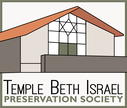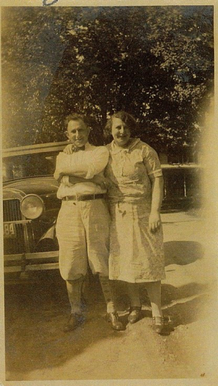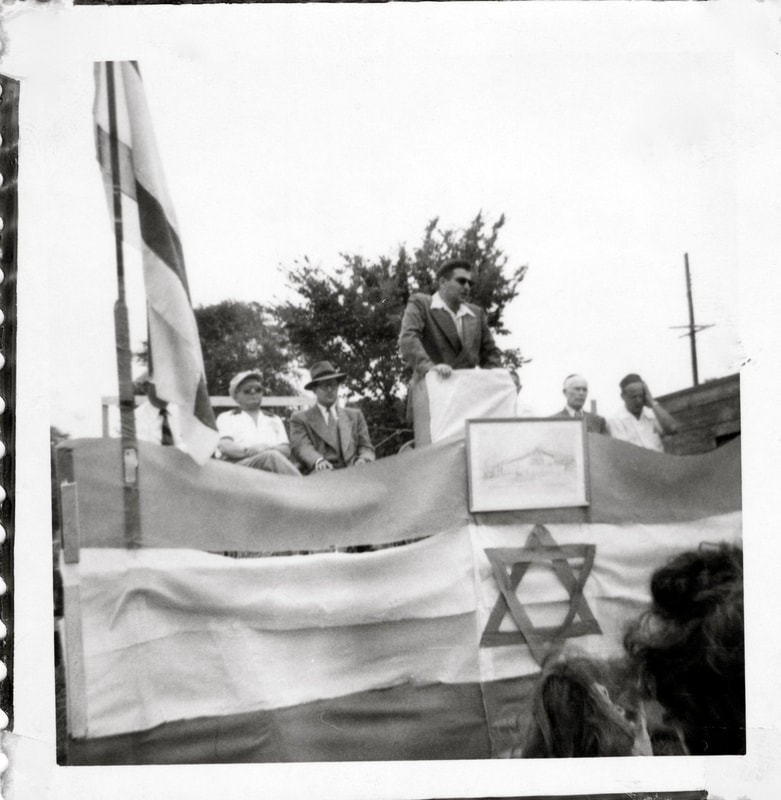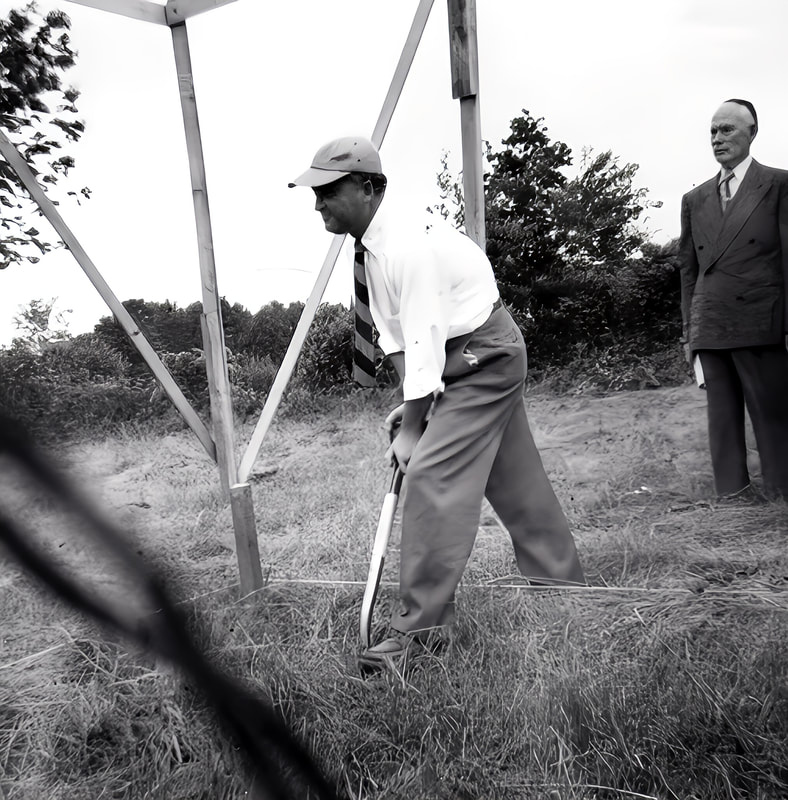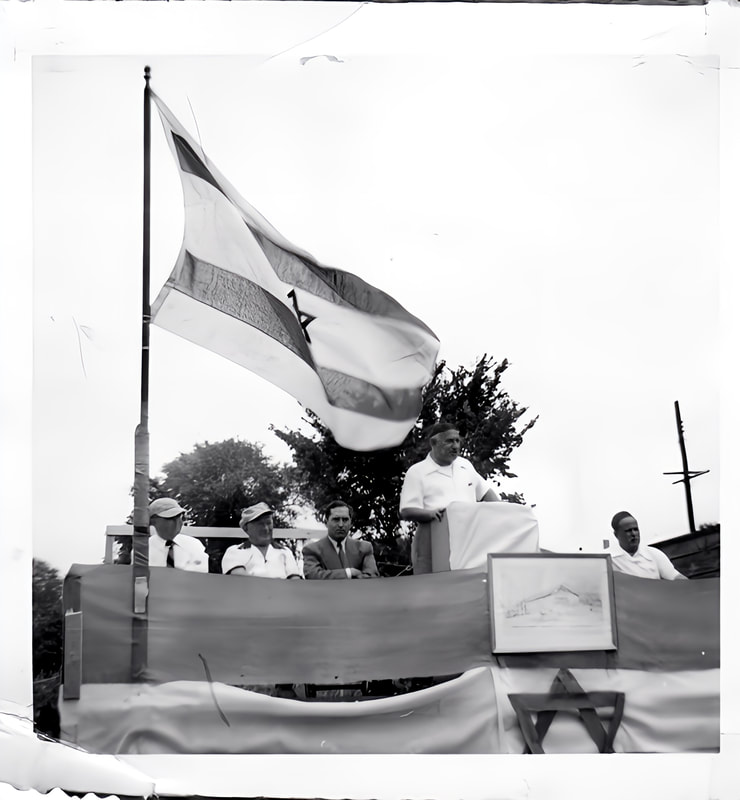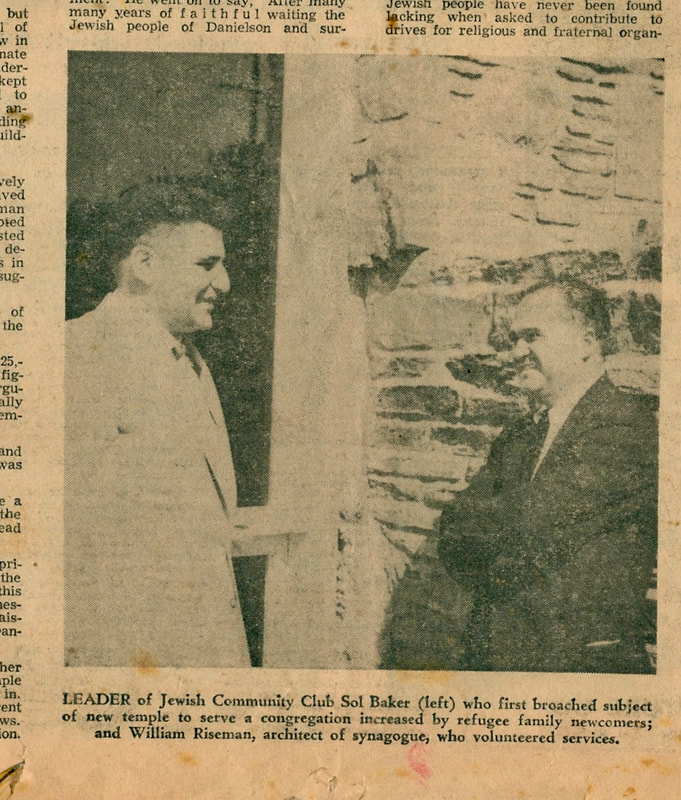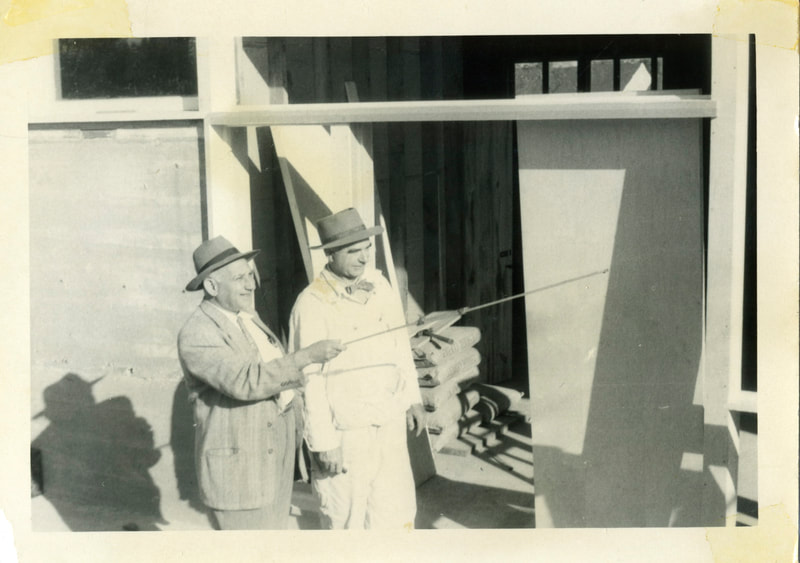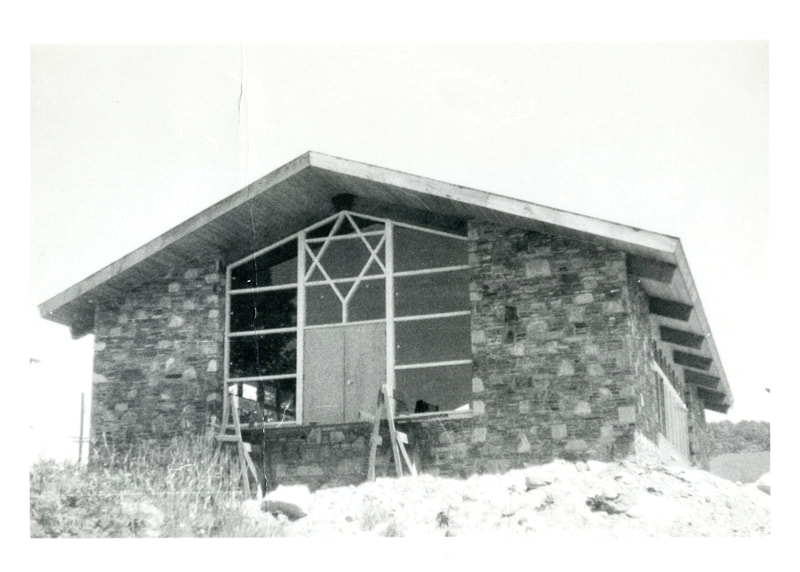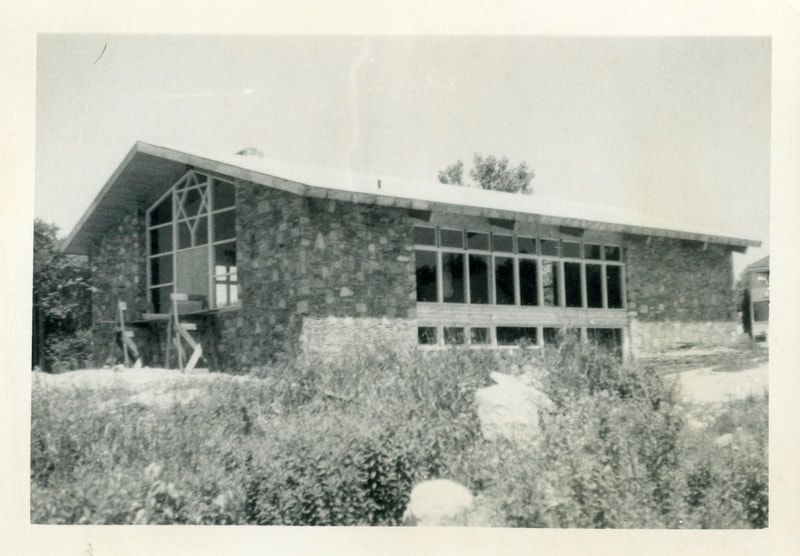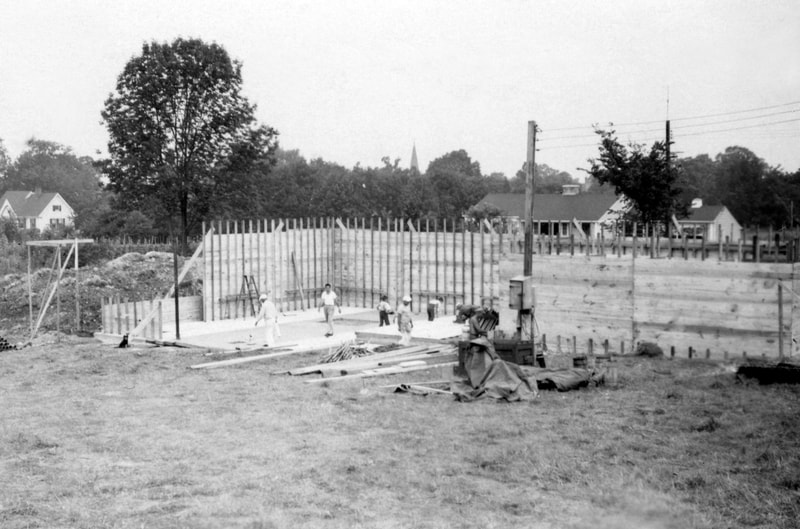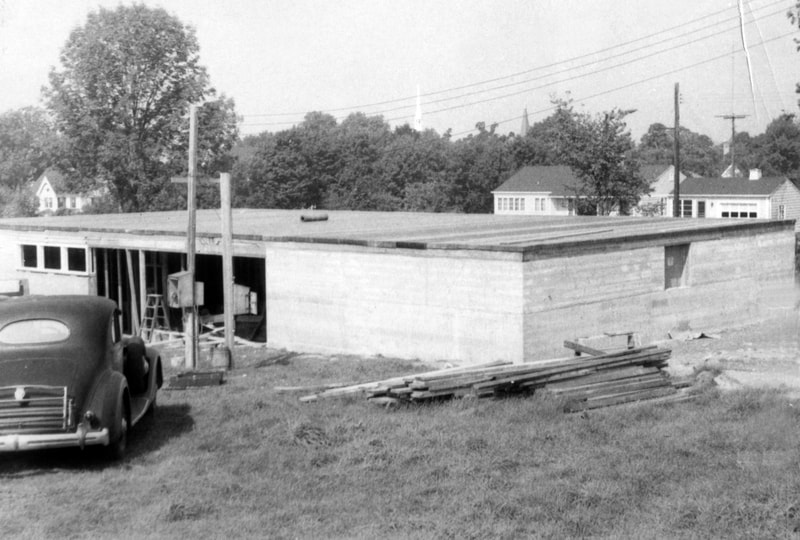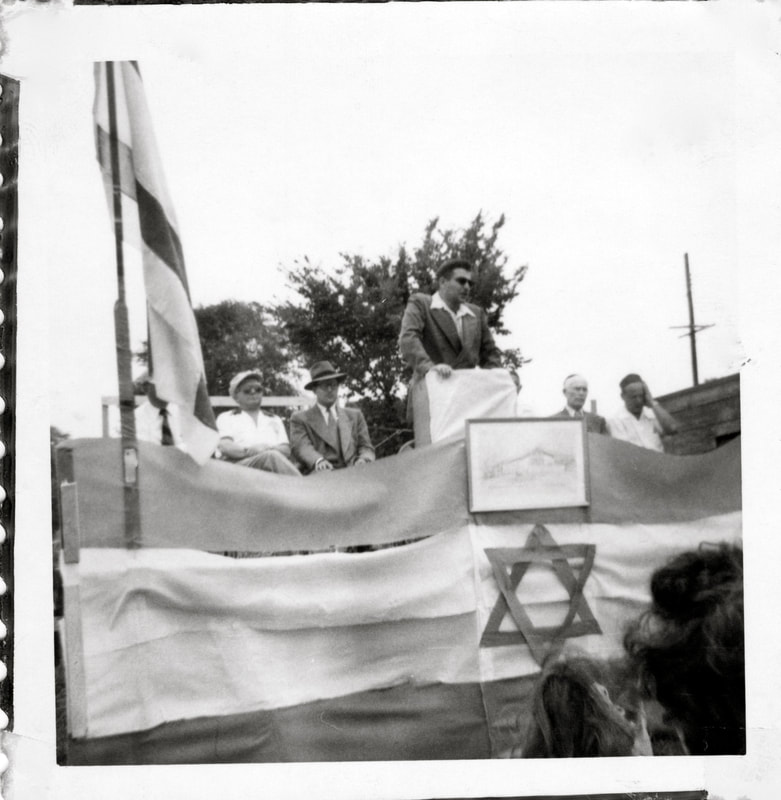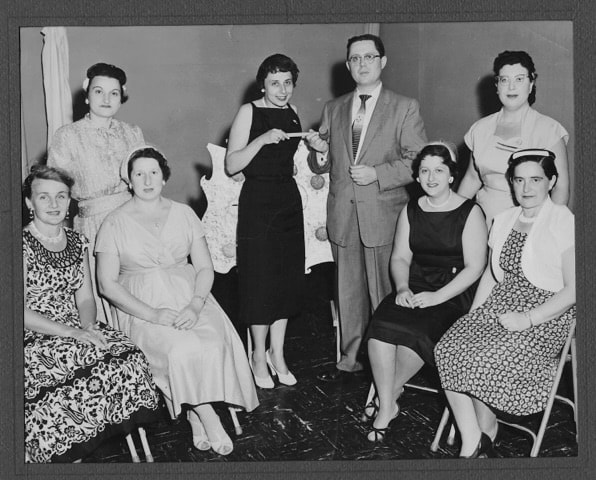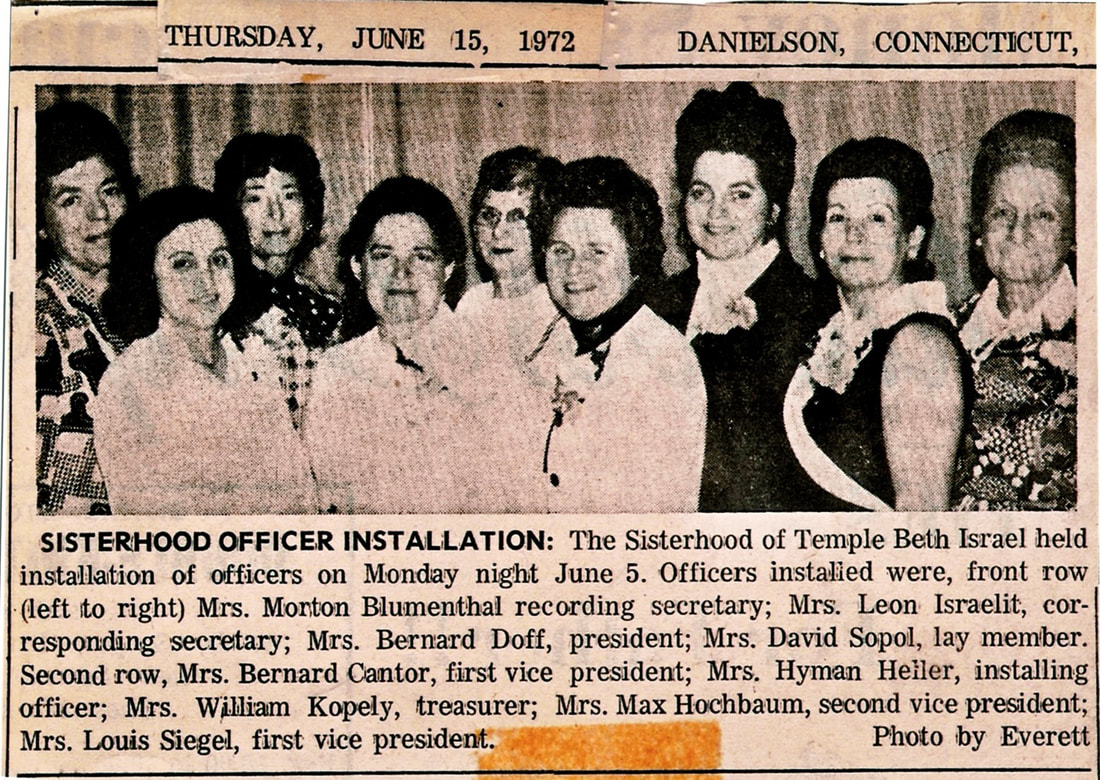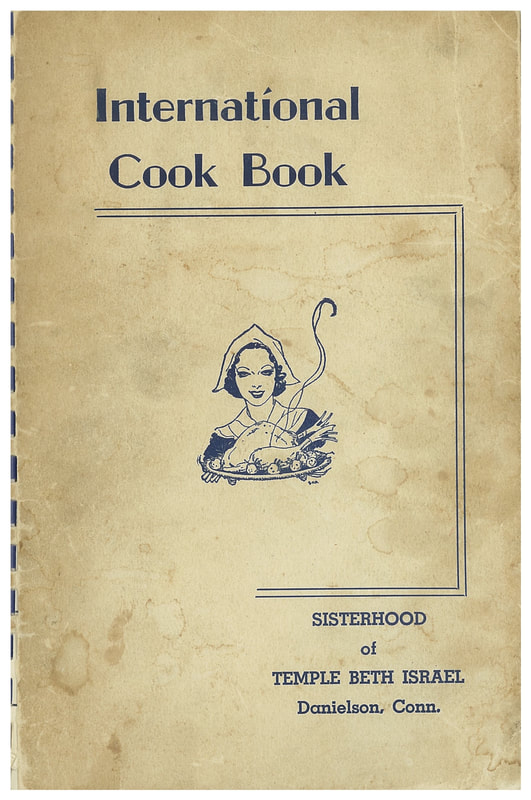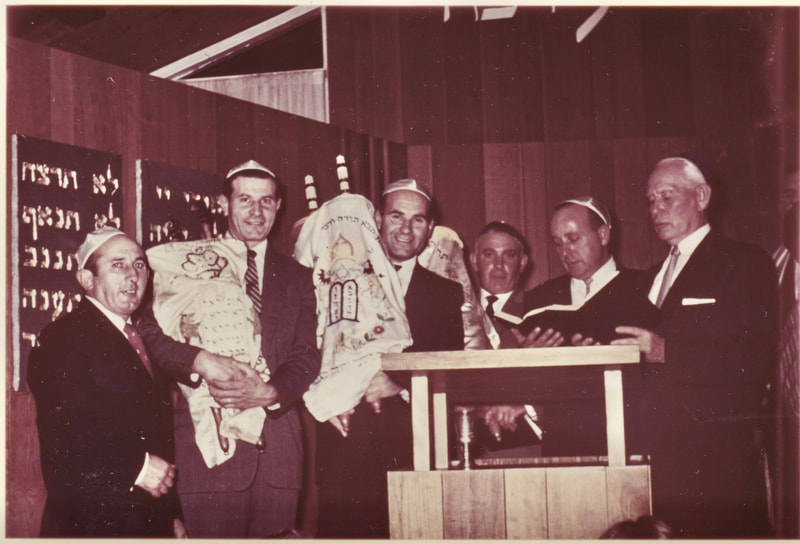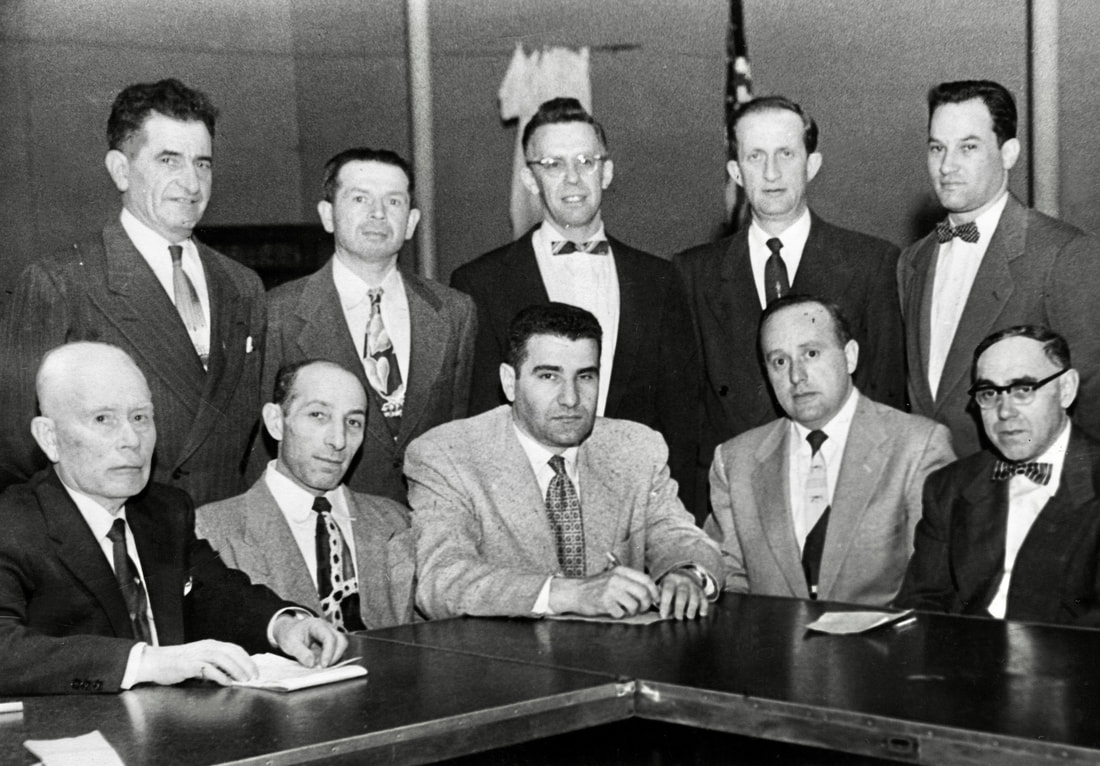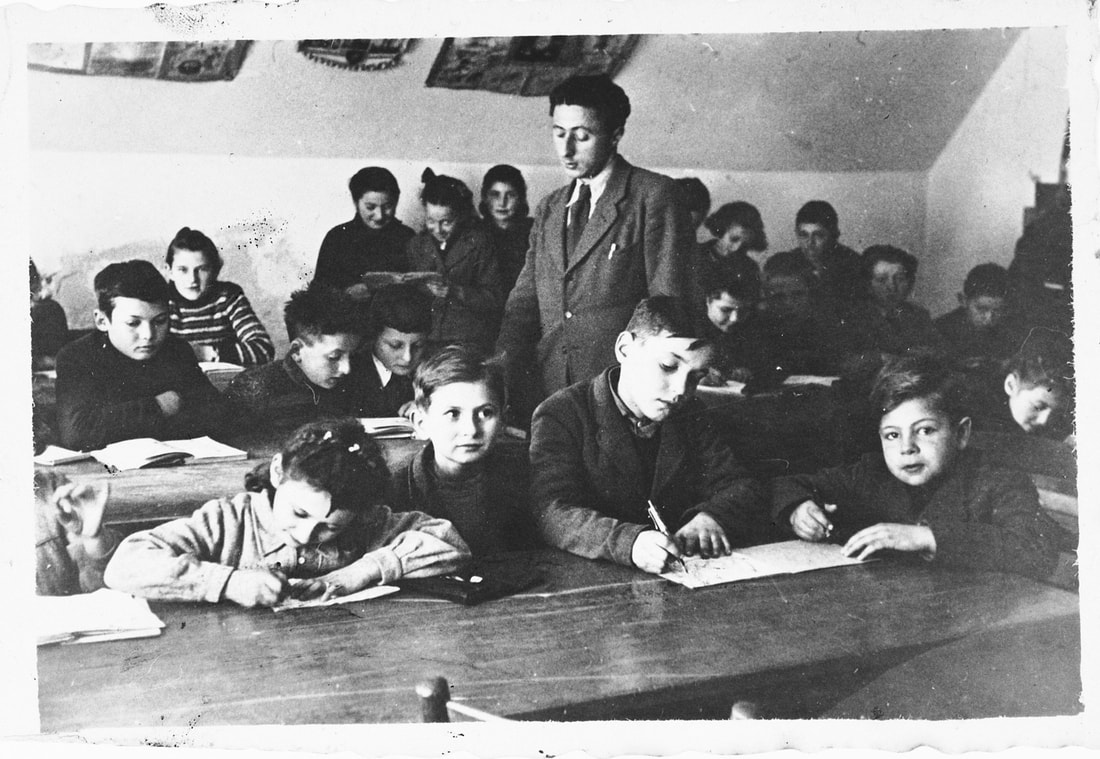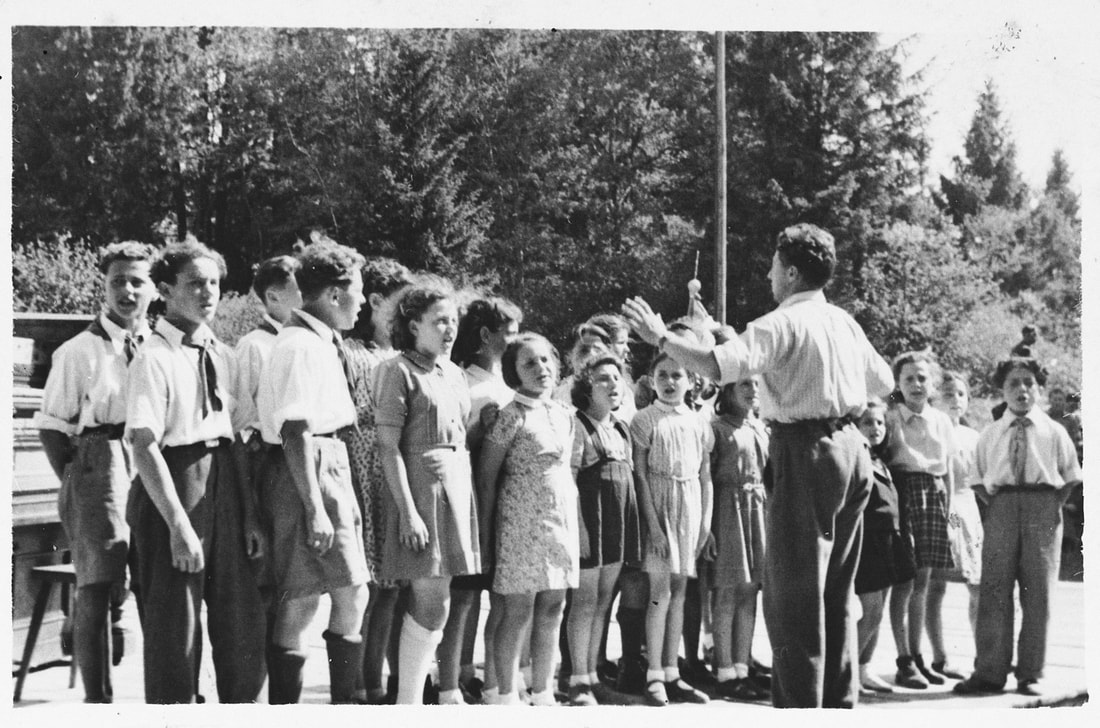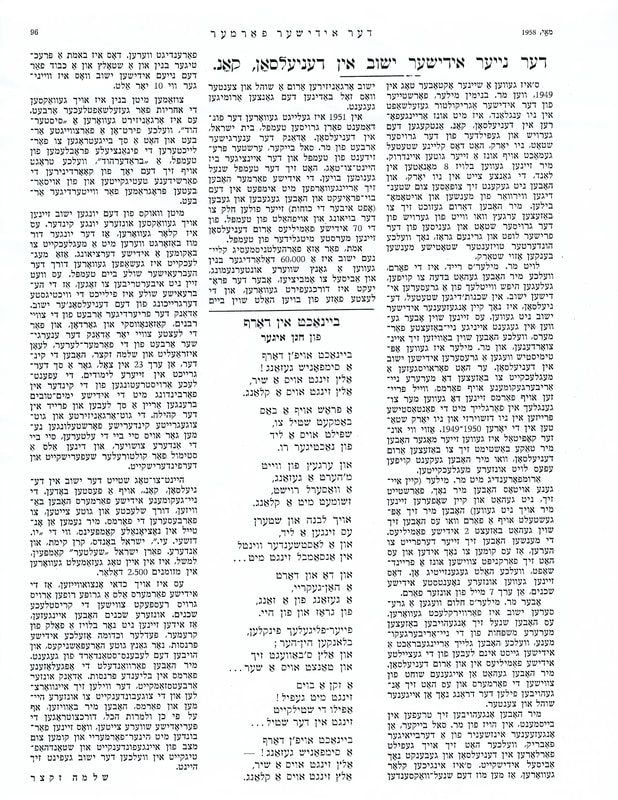History of Temple Beth Israel
This history is a work in progress. It is based on recollections, interviews with children of founding members, a review of Temple records, correspondence, board minutes and also on a history prepared for the Temple’s Thirtieth Anniversary Celebration which took place November 2, 1980. The story is incomplete. There will be errors and there are surely omissions. The research will continue as it is an important component of the Mission of the Temple Beth Israel Preservation Society. We invite readers to provide us with additional detail. Please share your stories and memories with us. Use the Contact Us link or send us a letter. We will expand and edit this history as we continue to learn more about our intriguing past.
Danielson, Connecticut
Danielson is a small, New England town located in the Northeast corner of Connecticut. The population of Danielson has always hovered between 5,000 and 10,000 residents. This area has come to be known as the “Quiet Corner.” It is surrounded by rivers, lakes, forests and meadows. Steeped in colonial history, there remains a strong connection with the original settlers in the region who were Puritans. The area has a distinct Yankee culture with strong roots in the Puritan tradition as expressed in Congregational churches. The emphasis has been on personal piety, thrift, hard work, and devotion to civic duty. There is also strong tradition of support for reform movements including abolition of slavery, temperance in the use of alcohol, women’s rights and education. During the late 1800s and for the first half of the 20th century there was a strong growth of manufacturing with the building of many mills and factories along the rivers and rail lines that traversed the region. Danielson typified small town New England qualities and characteristics.
two kinds of jews
To understand the Jewish community in Danielson requires a familiarity with two fundamentally different kinds of Jews. First there were the “old” Americans – Jews who had settled in the area before World War II. In 1945 there were some ten “old” American Jewish families living in and around Danielson. They were professionals, business owners or employed by local businesses. Then there were the “new” Americans – Jewish immigrants from Europe who settled in the area after the end of World War II, These Jews had lived in Europe, many in the Pale of Settlement, spoke Yiddish, Polish, Russian and other languages and in one way or another had experienced the horrors of the Holocaust. They had lost their homes and possessions. Family members and loved ones had been murdered or died of disease or starvation.
Many of these Holocaust Survivors had been imprisoned in ghettos in and around European cities. Many had spent time as slave laborers in concentration camps. They were led on death marches. Some had fought Hitler’s army as partisans, Some spent the war in hiding. Nearly all came to the US from displaced persons camps in Europe where some of their children were born. Over forty Jewish refugee families arrived in the Danielson area between 1948 and 1952.
The story of the Jews of Danielson is the story of how these two dramatically different groups came together to form one dynamic community.
Many of these Holocaust Survivors had been imprisoned in ghettos in and around European cities. Many had spent time as slave laborers in concentration camps. They were led on death marches. Some had fought Hitler’s army as partisans, Some spent the war in hiding. Nearly all came to the US from displaced persons camps in Europe where some of their children were born. Over forty Jewish refugee families arrived in the Danielson area between 1948 and 1952.
The story of the Jews of Danielson is the story of how these two dramatically different groups came together to form one dynamic community.
An American Story
|
|
In 1924, Nathan and Dora Blumenthal married and moved to Danielson. This was the first Jewish family to settle in Danielson. Over the next twenty-five years the Blumenthals were joined by nine other families. These “old” Americans made their homes in and around this village and successfully acclimated to the local cultural life without fully assimilating or relinquishing their Jewishness. Many of these families ordered kosher meat from Hertz Brothers in nearby Norwich, Connecticut which would arrive by bus and be picked up at the bus station in Danielson. Many owned or were employed by local businesses. Their children attended local schools.
The Blumenthals had brought a Torah with them from Norwich, Connecticut and for many years they held services in their home at 9 Winter Street in Danielson. Services were started at 7:00 am so that the businesspeople could get to their stores by 8:00 am. They had become part of the fabric of local, rural, small town, American life. They formed the Danielson Jewish Community Club. This group held meetings, services and rituals in the Blumenthal home and the home of Sol Baker, a local business executive. Bar Mitzvahs were held at members’ homes. For high holidays the Community Club would rent different building in town including the Elks and the American Legion Hall. By virtue of its small size, the Jewish community naturally avoided the sectarian differences that sometimes confounded their metropolitan counterparts. The handful of Danielson Jews could not afford the luxury of disagreements about how to live as Jews. Although they constituted a barely visible minority, these Jews were recognizable participants in the local cultural and civic life. Through their membership in the Jewish Community Club they worked to build and maintain their identity as Jews even as they nurtured their connections to the gentile community. Families such as the Bakers and the Blumenthals took a leadership role in the community and were highly respected. Nathan Blumenthal was the Commander of the American Legion and led a fund drive to raise money for the first ambulance in the community. He served on many boards including the local hospital, the Bond drive, the Danielson Industrial Foundation, Red Cross, Salvation Army and more. Unlike the multitude of Jews who settled in urban areas, these families settled in this area in search of economic independence, relief from overcrowding, greater access to outdoor pursuits and a desire to participate in all manner of “mainstream American” civic endeavors. After World War II Jewish survivors of the Holocaust began to make their way to America from displaced persons camps operated by the United Nations and the International Red Cross. Two thirds of European Jewry was annihilated in the Holocaust. An estimated 140,000 survivors came to the US in the years immediately following the Second World War. Many had lost whole families. They arrived with few possessions; no money and wearing donated clothing. |
Many members of the new American families that initially arrived in Danielson had emerged sick and emaciated from the concentration camps. For these immigrants, the war was seared into their consciousness in ways that would remain with them for the rest of their lives. Their experiences would affect how they lived, how they viewed the world and how they interacted with their children and their new neighbors.
For the most part, these individuals demonstrated great resilience and somehow, they managed to come back to life and become productive members of their new community. Many had married in the displaced persons camps. Some of their children were born in the camps or on the journey to America. They had a rich and varied social life and contributed much while forging a distinct identity for themselves which was strongly influenced by all they had endured.
Their resilience came into play as they settled into their new American lives and realized that they were no longer hated and hunted. Once settled and convinced that they were out of immediate danger, their views and personalities came to the fore and they became full-fledged members of the community. Their challenge was to learn to live and hope again.
While they experienced similar treatment in the camps and ghettos, these survivors came from a variety of backgrounds. Some were from wealthy families; some were dirt poor. Some came from urban others from rural environments. Some were educated, others were not. Some were religiously observant, others were not. They were children of tradesmen, students, teachers, writers, musicians, laborers, blacksmiths, and scholars. There were varying stripes of political identification from conservative to radical. Yiddish was the language for most of these refugees. Many brought with them the primitive practices and superstitions of the old world.
These immigrants were assisted in adjusting to their new lives by the Jewish Agricultural Society. Founded at the turn of the century by the Baron de Hirsch Fund to promote farming among Jews in the United States, the Society was instrumental in encouraging and helping these survivors to settle in rural communities and take up farming which, at that time, was an expanding industry in the region. Benjamin Miller was the regional agent for the Agricultural Society. Between 1948 and 1952, Miller helped over forty Jewish families, “new Americans” from Europe, settle on farms in the Danielson area to seek new lives.
Since none of the refugees had money with which to buy their land, they borrowed from relatives, banks, and the Jewish Agricultural Society. Most of these “new Americans” knew nothing about farming but they were willing to work hard and learn.
The encounter between the “old” and “new” Americans must have been fascinating. It all happened over the span of a mere two to four years. The arrival of the “new” Americans meant greater numbers and the possibility of building a real Jewish community. There was an outpouring of enthusiastic support and welcome.
Everyone knew what had happened in Europe and had a personal stake in supporting the new arrivals and helping them to adapt to their new lives. There were loans, gifts and advice. In fact, when the farmers first arrived, there was a “barter” arrangement where they would purchase needed items at Blumenthal’s hardware store and pay for them with eggs and chickens. Culturally, however, these immigrants who were just off the boat brought with them the usual negative stereotypes associated with European Jews. Yiddish was their first language. Their English-speaking skills were either nonexistent or heavily accented and filled with nightmarish grammatical constructions. They brought with them many primitive practices and superstitions from the “old” world. This could pose a threat to the equilibrium that had developed over decades between the “old” Americans and the surrounding community.
Things could have gone either way, but the “old” and “new” Americans realized that their destinies were intertwined through historical happenstance. This would be challenging but they knew they had no choice but to work together at building a strong, new Jewish community. They recognized early on that they would need a place of worship for themselves and for their growing families. It was in Danielson that these two very different groups of Jews – old and new Americans – with entirely different backgrounds and experiences came together and formed a remarkable community.
With the sudden growth of the Jewish population during the years 1948 and 1949, the members of the Jewish Community Club began to discuss the need to build a synagogue and community center. The community was quickly reaching a critical mass where a building and structured programs could be sustained. Most of the newcomers had young children and lived on farms far from other families with children. They wanted their children to benefit socially and educationally through interaction with other Jewish children. Shlomo Zektzer, one of the first survivors to settle in the Danielson area, wrote an article in Yiddish describing the experience of the new settlors. See A New Jewish Settlement in Danielson, Connecticut.
For the most part, these individuals demonstrated great resilience and somehow, they managed to come back to life and become productive members of their new community. Many had married in the displaced persons camps. Some of their children were born in the camps or on the journey to America. They had a rich and varied social life and contributed much while forging a distinct identity for themselves which was strongly influenced by all they had endured.
Their resilience came into play as they settled into their new American lives and realized that they were no longer hated and hunted. Once settled and convinced that they were out of immediate danger, their views and personalities came to the fore and they became full-fledged members of the community. Their challenge was to learn to live and hope again.
While they experienced similar treatment in the camps and ghettos, these survivors came from a variety of backgrounds. Some were from wealthy families; some were dirt poor. Some came from urban others from rural environments. Some were educated, others were not. Some were religiously observant, others were not. They were children of tradesmen, students, teachers, writers, musicians, laborers, blacksmiths, and scholars. There were varying stripes of political identification from conservative to radical. Yiddish was the language for most of these refugees. Many brought with them the primitive practices and superstitions of the old world.
These immigrants were assisted in adjusting to their new lives by the Jewish Agricultural Society. Founded at the turn of the century by the Baron de Hirsch Fund to promote farming among Jews in the United States, the Society was instrumental in encouraging and helping these survivors to settle in rural communities and take up farming which, at that time, was an expanding industry in the region. Benjamin Miller was the regional agent for the Agricultural Society. Between 1948 and 1952, Miller helped over forty Jewish families, “new Americans” from Europe, settle on farms in the Danielson area to seek new lives.
Since none of the refugees had money with which to buy their land, they borrowed from relatives, banks, and the Jewish Agricultural Society. Most of these “new Americans” knew nothing about farming but they were willing to work hard and learn.
The encounter between the “old” and “new” Americans must have been fascinating. It all happened over the span of a mere two to four years. The arrival of the “new” Americans meant greater numbers and the possibility of building a real Jewish community. There was an outpouring of enthusiastic support and welcome.
Everyone knew what had happened in Europe and had a personal stake in supporting the new arrivals and helping them to adapt to their new lives. There were loans, gifts and advice. In fact, when the farmers first arrived, there was a “barter” arrangement where they would purchase needed items at Blumenthal’s hardware store and pay for them with eggs and chickens. Culturally, however, these immigrants who were just off the boat brought with them the usual negative stereotypes associated with European Jews. Yiddish was their first language. Their English-speaking skills were either nonexistent or heavily accented and filled with nightmarish grammatical constructions. They brought with them many primitive practices and superstitions from the “old” world. This could pose a threat to the equilibrium that had developed over decades between the “old” Americans and the surrounding community.
Things could have gone either way, but the “old” and “new” Americans realized that their destinies were intertwined through historical happenstance. This would be challenging but they knew they had no choice but to work together at building a strong, new Jewish community. They recognized early on that they would need a place of worship for themselves and for their growing families. It was in Danielson that these two very different groups of Jews – old and new Americans – with entirely different backgrounds and experiences came together and formed a remarkable community.
With the sudden growth of the Jewish population during the years 1948 and 1949, the members of the Jewish Community Club began to discuss the need to build a synagogue and community center. The community was quickly reaching a critical mass where a building and structured programs could be sustained. Most of the newcomers had young children and lived on farms far from other families with children. They wanted their children to benefit socially and educationally through interaction with other Jewish children. Shlomo Zektzer, one of the first survivors to settle in the Danielson area, wrote an article in Yiddish describing the experience of the new settlors. See A New Jewish Settlement in Danielson, Connecticut.
Raising Money to Raise a Building
So a Temple was a fine idea, but where would the money come from? The “old” American families could not afford to donate the thousands of dollars that would be necessary and surely the newcomers could not help. Nevertheless, a committee was established to explore fund raising possibilities. Another committee was formed to look for potential building sites and a third was charged with looking at older buildings which might be renovated.
The Riseman family had lived in Brooklyn, Connecticut for some fifteen years. Mary Riseman supported the idea of a new building and donated the stone which would be used in the construction of the exterior. Her son, William, a noted architect in Boston, became interested in the Temple project. He designed the Temple building for this new Jewish community. He donated his services free of charge in memory of his mother who died in December 1950. An option was taken on a plot of land on Killingly Drive, on the edge of town, and the group prepared to construct a building at a projected original cost of $25,000. This amount seemed an enormous sum to a group of modest means, but after much debate, the decision was made to proceed with the project.
Now fund-raising became a primary challenge. Sol Baker headed the finance committee with help from Saul Silverstein, then president of the Rogers Corporation, and Peter Berris, a prominent Danielson citizen of Greek ancestry. Nathan Blumenthal provided valuable access to the local business community. $3,000 was raised from among the membership. $1,500 was paid for the land. Ground was broken on July 22, 1951, in a solemn, outdoor ceremony. The dais was the bed of a large truck festooned with blue and white fabric banners and featuring the flags of the United States and Israel at each side. The excitement and resolve were evident.
The families contributed another $3,000 for the building’s foundation, but then they decided to try fund-raising from the community at large. There was some trepidation about this, since they had never asked for help before, and had no idea about how the community would respond, but the amount of money needed to build their Temple necessitated a fund drive outside of their immediate group.
With the help of the local newspaper, the Windham County Transcript, and its owner, Adrian Herkots, the project got underway. The response was heartwarming. Ministers and priests urged their congregations to support the enterprise. J.W. Powdrell, former head of Alexander and Powdrell Curtain Company was approached and had already prepared a check for $1,000.
Many local residents contributed much smaller amounts, some even stopping members of the Temple on the street in order to donate one or two dollars. Hugh Gorman, a local farmer who had been a first selectman of the Town of Brooklyn, auctioned off one of his cows and contributed the proceeds to the Temple building fund. Gorman could easily relate to the Temple’s origins as his family was among the founders of Our Lady of La Salette, a Catholic church in Brooklyn. He was also president of the Windham County Agricultural Society from 1949 to 1958. Before that church was built in 1939, Sunday Mass was held in the Brooklyn Town Hall.
Six thousand dollars was raised in this first drive and even more important, the Jewish families knew from the outpouring of support from their neighbors that they were welcome in Danielson. In the next phase of the project, letters were sent to industrial firms and suppliers who were connected with stores, factories and farms in Danielson. From this second drive another $6,000 was raised. Now with a total of $20,000 from various sources, the Temple had a completed basement with kitchen and bathroom facilities and a heating system. The roof was the wooden floor of the main floor which, for some time, was covered with tarpaper.
With the first phase complete, some problems surfaced. There was concern that the building’s cost had materially increased over the original estimate, and that decisions were being made by a few individuals behind closed doors. Some members even threatened to leave and start their own temple. These issues were discussed with great animation and fervor at a public meeting and ultimately resolved satisfactorily. As in every community, there were disagreements over the years but none that ever threatened the coherence and stability of the community.
A small group of members signed a $30,000 mortgage to continue the building. After some discussion, it was decided to take only a $15,000 mortgage and complete the shell of the building. Contributions continued to accumulate from individuals and companies from as far away as Hartford and Worcester.
The Riseman family had lived in Brooklyn, Connecticut for some fifteen years. Mary Riseman supported the idea of a new building and donated the stone which would be used in the construction of the exterior. Her son, William, a noted architect in Boston, became interested in the Temple project. He designed the Temple building for this new Jewish community. He donated his services free of charge in memory of his mother who died in December 1950. An option was taken on a plot of land on Killingly Drive, on the edge of town, and the group prepared to construct a building at a projected original cost of $25,000. This amount seemed an enormous sum to a group of modest means, but after much debate, the decision was made to proceed with the project.
Now fund-raising became a primary challenge. Sol Baker headed the finance committee with help from Saul Silverstein, then president of the Rogers Corporation, and Peter Berris, a prominent Danielson citizen of Greek ancestry. Nathan Blumenthal provided valuable access to the local business community. $3,000 was raised from among the membership. $1,500 was paid for the land. Ground was broken on July 22, 1951, in a solemn, outdoor ceremony. The dais was the bed of a large truck festooned with blue and white fabric banners and featuring the flags of the United States and Israel at each side. The excitement and resolve were evident.
The families contributed another $3,000 for the building’s foundation, but then they decided to try fund-raising from the community at large. There was some trepidation about this, since they had never asked for help before, and had no idea about how the community would respond, but the amount of money needed to build their Temple necessitated a fund drive outside of their immediate group.
With the help of the local newspaper, the Windham County Transcript, and its owner, Adrian Herkots, the project got underway. The response was heartwarming. Ministers and priests urged their congregations to support the enterprise. J.W. Powdrell, former head of Alexander and Powdrell Curtain Company was approached and had already prepared a check for $1,000.
Many local residents contributed much smaller amounts, some even stopping members of the Temple on the street in order to donate one or two dollars. Hugh Gorman, a local farmer who had been a first selectman of the Town of Brooklyn, auctioned off one of his cows and contributed the proceeds to the Temple building fund. Gorman could easily relate to the Temple’s origins as his family was among the founders of Our Lady of La Salette, a Catholic church in Brooklyn. He was also president of the Windham County Agricultural Society from 1949 to 1958. Before that church was built in 1939, Sunday Mass was held in the Brooklyn Town Hall.
Six thousand dollars was raised in this first drive and even more important, the Jewish families knew from the outpouring of support from their neighbors that they were welcome in Danielson. In the next phase of the project, letters were sent to industrial firms and suppliers who were connected with stores, factories and farms in Danielson. From this second drive another $6,000 was raised. Now with a total of $20,000 from various sources, the Temple had a completed basement with kitchen and bathroom facilities and a heating system. The roof was the wooden floor of the main floor which, for some time, was covered with tarpaper.
With the first phase complete, some problems surfaced. There was concern that the building’s cost had materially increased over the original estimate, and that decisions were being made by a few individuals behind closed doors. Some members even threatened to leave and start their own temple. These issues were discussed with great animation and fervor at a public meeting and ultimately resolved satisfactorily. As in every community, there were disagreements over the years but none that ever threatened the coherence and stability of the community.
A small group of members signed a $30,000 mortgage to continue the building. After some discussion, it was decided to take only a $15,000 mortgage and complete the shell of the building. Contributions continued to accumulate from individuals and companies from as far away as Hartford and Worcester.
An Incomplete Building Houses a Complete Community
While the construction of the Temple was underway, religious services were held in the basement, conducted by visiting rabbis, usually students from New York. The services were alternately Conservative and Orthodox since members of the community were of both backgrounds. Throughout, there was active and capable participation by the members of the community, many of whom had considerable education and training in the Jewish history, liturgy and cultural matters. The first group of Temple officers was elected. Sol Baker was elected as the first president.
Elsie Fetterman was elected by the women to lead a new Sisterhood. A Hebrew school was started, and a youth group was formed. It was clear that the Temple could operate with or without a completed building.
Well before the building was completed, many activities were taking place, in what was quickly becoming a dynamic and active Jewish community. Religious services were held every Friday evening and for all holidays. With the help of Rabbi Israel Gordon of Worcester, there was a Hebrew school that met twice weekly and on Sundays. Teachers were recruited from a variety of communities from Norwich to Worcester.
The first Bar Mitzvah in 1954 was Meyer Blumenthal. Vita Fetterman was the first to be married in the Temple. There were special holiday observances including a model Seder. A Succah was built and decorated in the courtyard. Simchat Torah celebrations had the children singing songs and marching in line while carrying little Israeli flags topped with an apple and a lit candle. A library was started in 1956 by Pearl Kopely and Jeannette Katz. It was during these first ten years that the community took on its color, its flavor and its unique character. There was the din of Yiddish, arguments, debates. The men were fierce and pragmatic, the women were resourceful anand the children were exuberant.
By 1955, the shell of the main floor was complete, and a last effort was made to finish this house of worship. Many individuals donated funds for the Bima, the Holy Ark, and other finishing touches:
One of the Torahs was donated by Meyer Goldstein, father of Benjamin Goldstein at a large party that was held in 1962. A particularly unique donation was made by David Rosenberg who, while serving in the armed forces in Europe during World War II, came upon a shofar in a bombed synagogue. Under the presidency of Isidore Levine, a completed Temple Beth Israel was dedicated on June 5, 1961 in a most joyous celebration of a dream realized, through hard work and determination.
The dedication ceremonies were described in a news article appearing on June 12, 1961. The headline read: 250 Attend Dedication at Temple Beth Israel Sunday. Here is an excerpt: “Isidore Levine, president of the congregation, formally welcomed the guests and started the festivities with the colorful procession to transfer the Holy Scriptures to the new Ark, their permanent home. Mr. Levine then spoke of the deep significance of this dedication to the congregation. He expressed gratitude to them and to their Christian friends and neighbors whose cooperation was so helpful in building the temple…Special mention and thanks were also given to the architects, William Riseman and Mr. Finegold and to the carpenter, Mr. Hopkins.”
It did not take long for Danielson to grow into a colorful and dynamic Jewish community. To the visitor walking into Temple Beth Israel at a religious service or on a holiday, it was like walking into a shul somewhere in Eastern Europe before the war. It was loud, boisterous, Yiddish, some broken English and a smattering of proper English. Everywhere there was laughter, spirited arguments, and singing. One was transported in time and place. It was a fascinating confluence of the strangeness of Eastern Europe tempered by Yankee dignity, manners, ingenuity and a strong, mutual respect and appreciation for hard work, honesty, and determination.
Elsie Fetterman was elected by the women to lead a new Sisterhood. A Hebrew school was started, and a youth group was formed. It was clear that the Temple could operate with or without a completed building.
Well before the building was completed, many activities were taking place, in what was quickly becoming a dynamic and active Jewish community. Religious services were held every Friday evening and for all holidays. With the help of Rabbi Israel Gordon of Worcester, there was a Hebrew school that met twice weekly and on Sundays. Teachers were recruited from a variety of communities from Norwich to Worcester.
The first Bar Mitzvah in 1954 was Meyer Blumenthal. Vita Fetterman was the first to be married in the Temple. There were special holiday observances including a model Seder. A Succah was built and decorated in the courtyard. Simchat Torah celebrations had the children singing songs and marching in line while carrying little Israeli flags topped with an apple and a lit candle. A library was started in 1956 by Pearl Kopely and Jeannette Katz. It was during these first ten years that the community took on its color, its flavor and its unique character. There was the din of Yiddish, arguments, debates. The men were fierce and pragmatic, the women were resourceful anand the children were exuberant.
By 1955, the shell of the main floor was complete, and a last effort was made to finish this house of worship. Many individuals donated funds for the Bima, the Holy Ark, and other finishing touches:
- Lois & Bernard Mopsik
- Dora & Nathan Blumenthal
- Sandy & Solomon Baker
- Rose & Simon Katzoff
- Lil & Louis Seigel
- Mr. & Mrs. Boris Israelit
- Jeanette & Coleman Steuer
- Alma & Alter Teitelbaum
- Ray & Jacob Gawendo
- Chana & Leon Israelit
- Mrs. Fannie Kamenmacher
- Shirley & David Rosenberg
- Mr. & Mrs. Ben Rosen
- Evelyn & Robert Swan
- Sarah & Isidore Levine
- Betty & Morris Berman
One of the Torahs was donated by Meyer Goldstein, father of Benjamin Goldstein at a large party that was held in 1962. A particularly unique donation was made by David Rosenberg who, while serving in the armed forces in Europe during World War II, came upon a shofar in a bombed synagogue. Under the presidency of Isidore Levine, a completed Temple Beth Israel was dedicated on June 5, 1961 in a most joyous celebration of a dream realized, through hard work and determination.
The dedication ceremonies were described in a news article appearing on June 12, 1961. The headline read: 250 Attend Dedication at Temple Beth Israel Sunday. Here is an excerpt: “Isidore Levine, president of the congregation, formally welcomed the guests and started the festivities with the colorful procession to transfer the Holy Scriptures to the new Ark, their permanent home. Mr. Levine then spoke of the deep significance of this dedication to the congregation. He expressed gratitude to them and to their Christian friends and neighbors whose cooperation was so helpful in building the temple…Special mention and thanks were also given to the architects, William Riseman and Mr. Finegold and to the carpenter, Mr. Hopkins.”
It did not take long for Danielson to grow into a colorful and dynamic Jewish community. To the visitor walking into Temple Beth Israel at a religious service or on a holiday, it was like walking into a shul somewhere in Eastern Europe before the war. It was loud, boisterous, Yiddish, some broken English and a smattering of proper English. Everywhere there was laughter, spirited arguments, and singing. One was transported in time and place. It was a fascinating confluence of the strangeness of Eastern Europe tempered by Yankee dignity, manners, ingenuity and a strong, mutual respect and appreciation for hard work, honesty, and determination.
The Sisterhood
|
|
Perhaps the most active group of all members was the Sisterhood which seemed to have a constant schedule of activities. The first president of the Sisterhood was Elsie Fetterman who was elected to office in 1950 while she was away on her honeymoon. Elsie describes how each meeting opened with the singing of Hatikvah and how she had typed out the words since many of the “old” Americans did not know the words to the new anthem.
With assistance from Anna Israelit, they established a committee for every Jewish holiday. Since there were only eight members, each member was responsible for a committee and for a holiday. The Sisterhood helped to raise money through a variety of projects which engaged the local community. One such project was a card table project where the local merchants gave donations for ads which were printed on the tables. They also developed a cookbook with recipes from the members. In addition, there were special projects for fund raising such as Lawn Tea Parties, card parties, a Tablecloth project, a kitchen shower, and candy sales. Starting in 1955 under the guidance of Shirley Rosenberg, a new Years’ Greeting Book was begun. A gift shop was started, annual donor dinners were held, a Golden Book, Purim parties, Bingo, rummage sales all were well attended on a regular basis. |
THe CHILDREN
|
|
The Temple served as a community center for members of all ages. At a time when there were many children in the congregation, Leon Israelit organized an informal youth club with games and activities for children to enjoy together. Younger children had their own group – the Youth Group.
Under the direction of Mr. George Roback the Youth group celebrated holidays, put on plays with Israeli history or other Jewish themes, and raised money for annual trips to destinations such as Rocky Point in Warwick, RI and the Touro Synagogue in Newport. There were many directors, advisors, leaders and members – all dedicated, innovative and wonderful people. Youth Commission directors included Isidore Goldstein, Edward Rose, Dr. Herbert Schneider, Pyrle Kopely, Sophie Drobiarz, Harriet Drobiarz, Shirley Rosenberg and Doris Cantor. Advisors were recruited from a Jewish organization at the University of Connecticut. |
United Synagogue Youth
The older children (ages 13-18) formed the Danielson Chapter of the United Synagogue Youth under the direction of Mrs. Abraham Katz. This chapter became affiliated with the Connecticut Region of USY and, over the years, several USY members served on the Connecticut regional board. The USY chapter sent its teenagers to regional encampments, weekend gatherings (kinusim) dances and other social events.
The USY was not only for socializing. Religious services in the Temple were conducted by these young people, entertainment for the whole community, such as a production of Fiddler on the Roof, and rallies and collection of emergency fund donations during the Israeli Six Day War were normal events. The support from parents and the community aided the success of USY, an organization which helped to develop cultural and social awareness as young Jewish adults. This was also a time where the number of Bar and Bat Mitzvahs grew dramatically.
Presidents of the USY included Martin Israelit, Judy Rubin, Norman Berman, Dick Kopely, Rosalie Drobiarz, Jeff Green, Claire Israelit, Paula Rosenberg, Debra Doff, Joel Rosenberg, Marilyn Drobiarz, Sandra Drobiarz and Jeff Blumenthal.
The USY was not only for socializing. Religious services in the Temple were conducted by these young people, entertainment for the whole community, such as a production of Fiddler on the Roof, and rallies and collection of emergency fund donations during the Israeli Six Day War were normal events. The support from parents and the community aided the success of USY, an organization which helped to develop cultural and social awareness as young Jewish adults. This was also a time where the number of Bar and Bat Mitzvahs grew dramatically.
Presidents of the USY included Martin Israelit, Judy Rubin, Norman Berman, Dick Kopely, Rosalie Drobiarz, Jeff Green, Claire Israelit, Paula Rosenberg, Debra Doff, Joel Rosenberg, Marilyn Drobiarz, Sandra Drobiarz and Jeff Blumenthal.
Israel
The Temple was particularly supportive of the State of Israel. For this generation of Jews, Israel was a physical and a spiritual homeland. For the survivors, it represented the one place in the world where they would be welcome and safe. Each year, the United Jewish Appeal was strongly supported. Israel Independence Day was celebrated, and an Israel Bond drive was held. The community is justifiably proud of the fact that, for many years, Temple Beth Israel gave more per capita each year than any other town in Connecticut. Many local businesses and residents from the greater Christian community also attended and purchased the Israel Bonds to show their support of the Jewish community.
Over the years two special observances had become crucial parts of the permanent program at Temple Beth Israel. A Holocaust memorial Service was held each year in the spring, an event of particular meaning to the majority of the members of this community. In November of each year there was an interfaith Thanksgiving Service which was begun in 1955 by Reverend Edith Wolf, a minister of the Federated Church of Brooklyn, Connecticut and Dr. Herbert Schneider, an optometrist in Danielson. For many years Dr. Herbert Schneider and Henry Drobiarz represented Temple Beth Israel as partners in this interfaith gathering with the Federated Church of Brooklyn. This service which was held at the Temple and the Church on alternate years became a key event in the Temple’s calendar and enjoyed enthusiastic support from area congregations ever since. It is one of the oldest interfaith gatherings of its kind in Connecticut.
By 1975 the mortgage on the building was fully paid. At a gathering celebrating the Temple’s 25th anniversary, the mortgage document was burned. Those who had signed the mortgage and guaranteed its payment received special plaques commemorating the event.
Over the years two special observances had become crucial parts of the permanent program at Temple Beth Israel. A Holocaust memorial Service was held each year in the spring, an event of particular meaning to the majority of the members of this community. In November of each year there was an interfaith Thanksgiving Service which was begun in 1955 by Reverend Edith Wolf, a minister of the Federated Church of Brooklyn, Connecticut and Dr. Herbert Schneider, an optometrist in Danielson. For many years Dr. Herbert Schneider and Henry Drobiarz represented Temple Beth Israel as partners in this interfaith gathering with the Federated Church of Brooklyn. This service which was held at the Temple and the Church on alternate years became a key event in the Temple’s calendar and enjoyed enthusiastic support from area congregations ever since. It is one of the oldest interfaith gatherings of its kind in Connecticut.
By 1975 the mortgage on the building was fully paid. At a gathering celebrating the Temple’s 25th anniversary, the mortgage document was burned. Those who had signed the mortgage and guaranteed its payment received special plaques commemorating the event.
The Community Leaders
|
Every family in the Congregation contributed to its success in some meaningful way. Certain individuals were noteworthy, however, in their dedication, initiative and tireless devotion to enhancing and enriching community life. Listed below are just a few of the individuals who had a lasting impact on shaping and directing the Temple:
Sol Baker: Board member, president, businessman, hosted gatherings of the Danielson Jewish Community Club at his home not far from the site of the Temple. Sol was one of the visionaries who helped to make the Temple a reality. He was the first president of the community and served for several years. He helped to set the congregation firmly on its path to success. Nathan Blumenthal: Nathan and his wife Dora Blumenthal were the first Jews to settle in Danielson in 1924. They hosted gatherings for prayers and rituals at their home a 9 Winter Street in Danielson. Nathan owned and operated D. Blumenthal Hardware and Supply in Danielson. He was a prominent Jewish businessman and civic leader and the key liaison with many of the local business leaders in the Christian community. He was instrumental in raising funds for the new building. Henry Drobiarz – Survivor, dairy farmer, president of the Temple for many years. He served on the board of directors, the ritual committee, and was, for many years, the community’s lay spiritual leader. Henry was the “new” American counterpart to Sol Baker. With his ever-present charm and humor and a twinkle in his eye, he was a natural leader, community diplomat, spiritual leader for the entire span of the Temple’s history – starting in the early days and continuing well past the turn of the century. Henry and Sophie’s children and grandchildren are active in the Preservation Society and have served on its board of directors. Isidore Levine: Survivor and poultry farmer. He earned an engineering degree in Poland, lost nearly his entire family in the Holocaust, fought for the Polish army, met his wife in a displaced persons camp and settled on a farm in East Killingly. An avid reader, self-educated in American finance and politics, he served on the Temple’s board of directors and, for two years, was President of the congregation. Izzy and Sarah Levine left Danielson in the early 70s to acquire and operate the Leslie Hotel in Miami Beach, Florida. Many Temple members would stay at or visit the hotel when in Florida. Irving Fetterman: Local Businessman who negotiated the purchase of the land on Killingly Drive on which the Temple was built. The owners had property on both Killingly Drive and Corinne Street and would not sell one lot separately. Irving purchased both lots of for the Temple and then purchased the Corinne Street lot from the Temple. Irving was one of the founders who signed the mortgage. His knowledge of all matters electrical and plumbing proved invaluable to the new community, and he generously helped to provide necessary maintenance for the building’s mechanical systems. Leon Israelit: Teacher, resistance fighter, survivor, farmer. Leon Israelit served on the board of directors and was committed to advancing the level of education of the children. Israelit taught in the Hebrew School for many years together with his wife, Anna. Their children, Martin and Claire both serve on the Preservation Society board of directors. Stanley Zektzer: Survivor, farmer, writer, teacher and musician. Known also as Shlomo Zektzer, he formed and led a Yiddish youth chorus in the displaced persons camp Fohrenwald where other survivors who ultimately settled in Danielson were placed. Shlomo and his wife Rena were among the first immigrant settlers in the Danielson Jewish community. After his arrival in Danielson, he wrote an article published in the Yiddish monthly, Der Yidisher Farmer, (The Jewish Farmer), entitled Der Neier Yishuv in Danielson, (a new Jewish settlement in Danielson). (See article and translation elsewhere on this website.) Zektzer owned a chicken farm and was one of the teachers in the Temple’s newly formed Hebrew School. He also privately tutored students for their Bar Mitzvahs. Edward Rose: Board member, president, local business owner. He owned and operated Lord’s Shoes on Main Street in Danielson. An early member of the Danielson Jewish Club, Rose was one of the purchasers of the property on which the Temple was built. Elsie Fetterman: Member of the Blumenthal family, high school teacher, college professor and author. Elsie served as sisterhood president and youth adviser. A tireless researcher, Elsie has been instrumental in locating and reconnecting with many former members. Her memories of the early days of the development of the community have been an essential element in chronicling the Temple’s history. A strong supporter of the Preservation Society, Elsie has served on the board of directors and has spearheaded a successful program of securing grant funding for a variety of critical projects. Ray Gawendo: Holocaust Survivor, farmer. Over the years, Ray was active in the sisterhood and served as its president. In her 90s, she was urged to tell her story of survival and became a frequent speaker at high schools discussing her experiences during the Holocaust. Her husband, Jacob, served on the Temple’s original board of directors. Their son Evert serves as the Preservation Society’s vice president. Shirley Rosenberg: Sisterhood board member, Sisterhood secretary, Sisterhood treasurer, Youth Group/USY advisor. Shirley, a “macher,” moved to Danielson as a newlywed in May 1950. A first generation American, her first language was Yiddish – something that helped forge life-long friendships with later members of the congregation and sisterhood. Shirley worked side by side with her husband David (a mortgage signer for the Temple building) to build Danielson Surplus Sales into a successful business. She and Dave raised three children, Paula, Warren and Joel. Paula presently serves as the Preservation Society’s President and Joel was its first President and is now President Emeritus. Herman Sheppard: Holocaust survivor, farmer and entrepreneur. Dedicated and active member of the community. Herman Sheppard served on the board and as congregation president. He played a major role helping to raise funds to make a number of improvements to the Synagogue. Herman was instrumental in helping to keep the congregation moving forward at a critical time in the history of Temple Beth Israel. |
The Eighties and Nineties
In the early 1980s, membership in the congregation had dropped from a high of nearly 70 families to 25. The Sunday edition of the New York Times on August 30, 1981 contained an article about the Temple which featured Henry Drobiarz and Herman Sheppard in describing the community and its unusual story. For the next two decades Temple Beth Israel saw a further decline in membership as more and more families moved from the rural way of life to larger suburban communities spread throughout America. Older members were getting on in age and retired. Many retired to warmer climates in Florida, California and Arizona. A few moved to Israel. Some members died.
A small but dedicated group of members remained active and kept the doors of the Temple open. Year by year the congregation grew smaller. Three members in particular, Henry Drobiarz, Herman Sheppard, and Harold Blumenthal, stepped up to serve as stewards of the property and leaders of the congregation. The Sisterhood, with only seven women, under the leadership of co-presidents Paula Rosenberg Bell and Judy Helfgott remained a strong and viable part of the congregation. High Holiday services continued to be held as did Friday night services and the occasional ritual or celebration.
A small but dedicated group of members remained active and kept the doors of the Temple open. Year by year the congregation grew smaller. Three members in particular, Henry Drobiarz, Herman Sheppard, and Harold Blumenthal, stepped up to serve as stewards of the property and leaders of the congregation. The Sisterhood, with only seven women, under the leadership of co-presidents Paula Rosenberg Bell and Judy Helfgott remained a strong and viable part of the congregation. High Holiday services continued to be held as did Friday night services and the occasional ritual or celebration.
The Merger
By 2003, concerned about its diminishing membership, Temple Beth Israel entered into a merger with the Sons of Zion Synagogue in Putnam, Connecticut. The merger was prompted by recognition that both Temple Beth Israel and Sons of Zion had experienced reductions in their respective memberships. Since the two communities were separated by a mere ten miles, it was believed that merging into a single community would better serve the Jewish population in the area. For the following seven years the combined community known as Congregation B’nai Shalom operated satisfactorily utilizing the resources of both facilities to provide a broad range of services. It was during this period that, for the first time in many years, Temple Beth Israel was again being used for Bar and Bat Mitzvahs, Hanukah parties, and expanded High Holiday services.
There came a point, however, in or around 2008 when concerns developed about the direction and future of the Jewish community in the region. Some members who were more closely identified with the Putnam community decided to invest in land adjacent to the Putnam building and contemplated expansion of the Putnam facility to meet future needs. Other members became concerned that this plan would render the beautiful Danielson building superfluous. Joel Rosenberg, one of the board members, was persistent in his advocacy for preserving the Danielson Temple and maintaining it as a critical resource for the local Jewish community. He drew support from other members of the B’nai Shalom board including Paula Rosenberg Bell, Al Turner, Jen Wright, and Naomi Weiner. As debate continued about the future of the Danielson Temple, Joel Rosenberg put the word out to a small group of descendants of the original members of the Danielson Temple who quickly rallied to support his efforts to preserve the building and its legacy.
It did not take long for a number of individuals, many of whom lived in communities far from Danielson to answer Joel’s challenge to become active and engage in a preservation effort. Instrumental in this group were Jack Hodys, Evert Gawendo, Henry Mondschein, Rosa Drobiarz Goldblatt, Martin Drobiarz, Frances Hodys Brill, Rachel Sheppard Rubin, Paula Rosenberg Bell, Norman Berman, Fay Sheppard, Elsie Fetterman, Vita Fetterman Goldstein, and Sophie Hodys Soudai. This group of descendants of the original founders were joined by Marty and Naomi Weiner who had joined Temple Beth Israel before the merger took place. Marty and Naomi fully appreciated and passionately embraced the efforts to preserve the Temple and all that it represented.
All of these individuals shared the concern that the strong tradition, the beauty of the Danielson synagogue, the history of its founding, its close ties to the community of Holocaust survivors and their descendants were at risk of being lost. All recognized that the historical value of Temple Beth Israel and all that it stood for was in jeopardy in an effort to cut costs, downsize programming and otherwise focus on pressing financial needs. All resolved that this building and its history would be preserved.
There came a point, however, in or around 2008 when concerns developed about the direction and future of the Jewish community in the region. Some members who were more closely identified with the Putnam community decided to invest in land adjacent to the Putnam building and contemplated expansion of the Putnam facility to meet future needs. Other members became concerned that this plan would render the beautiful Danielson building superfluous. Joel Rosenberg, one of the board members, was persistent in his advocacy for preserving the Danielson Temple and maintaining it as a critical resource for the local Jewish community. He drew support from other members of the B’nai Shalom board including Paula Rosenberg Bell, Al Turner, Jen Wright, and Naomi Weiner. As debate continued about the future of the Danielson Temple, Joel Rosenberg put the word out to a small group of descendants of the original members of the Danielson Temple who quickly rallied to support his efforts to preserve the building and its legacy.
It did not take long for a number of individuals, many of whom lived in communities far from Danielson to answer Joel’s challenge to become active and engage in a preservation effort. Instrumental in this group were Jack Hodys, Evert Gawendo, Henry Mondschein, Rosa Drobiarz Goldblatt, Martin Drobiarz, Frances Hodys Brill, Rachel Sheppard Rubin, Paula Rosenberg Bell, Norman Berman, Fay Sheppard, Elsie Fetterman, Vita Fetterman Goldstein, and Sophie Hodys Soudai. This group of descendants of the original founders were joined by Marty and Naomi Weiner who had joined Temple Beth Israel before the merger took place. Marty and Naomi fully appreciated and passionately embraced the efforts to preserve the Temple and all that it represented.
All of these individuals shared the concern that the strong tradition, the beauty of the Danielson synagogue, the history of its founding, its close ties to the community of Holocaust survivors and their descendants were at risk of being lost. All recognized that the historical value of Temple Beth Israel and all that it stood for was in jeopardy in an effort to cut costs, downsize programming and otherwise focus on pressing financial needs. All resolved that this building and its history would be preserved.
Formation of the Temple Beth Israel Preservation Society
|
|
The concerns about the future of the former Temple Beth Israel awakened a new consciousness among this small group of descendants of the founding families of Temple Beth Israel. Led by Joel Rosenberg, a resident of Brooklyn, Connecticut, and a son of an American Jewish businessman who had settled in Danielson and opened Danielson Surplus Sales in 1950, the group shared a sense of urgency and a recognition that something of great value was at risk. They knew that the Temple represented more than a Jewish house of worship, not only to these descendants who had grown up and come of age in this Temple, but also to the community at large that had welcomed the Jews and supported the creation of the Temple and the community.
There was something of great importance to small town New England life that had occurred in this place and this small group of individuals was moved to do all it could to preserve the legacy, tell the story, honor their parents and create a resource that would contribute to the cultural and historic life of the greater community. In early 2009, several representatives of this group of descendants held a series of meetings with the leadership of Congregation B’Nai Shalom focused on the preserving the future of the Temple building. These descendants pressed for independent status for Temple Beth Israel. The discussions ultimately led to an agreement whereby ownership of Temple Beth Israel would be transferred to a newly formed Preservation Society whose mission would be to own and maintain the building and to establish a vibrant community center. |
A New Mission
On July 3, 2009, a meeting of incorporators was held, and a vote taken to adopt bylaws, elect officers and directors and to incorporate the Temple Beth Israel Preservation Society. Joel Rosenberg was elected the first president of the Preservation Society. Valuable support, consultation and assistance was provided by four of the founding members of the Temple, Ray Gawendo, Elsie Fetterman, Mort Blumenthal, and Herman Sheppard. A mission statement was drafted, and incorporation papers were filed with the State of Connecticut on July 23, 2009, establishing the new nonprofit corporation.
On April 2, 2010, the Internal Revenue Service officially advised the Preservation Society that its application for tax exempt status was approved effective July 23, 2009. The next challenge was to secure state and federal recognition of the historical importance of the building. After an exhaustive qualification process, on January 7, 2013, the Temple was listed on the State of Connecticut’s Register of Historic Places. On April 16, 2013, the Temple was listed on the National Register of Historic Places. The Preservation Society honored its unique history and its special place in the story of the Jewish community in Northeastern Connecticut on July 18, 2010, at a gala celebration commemorating the groundbreaking for the building of Temple Beth Israel.
With fond memories of a beautiful day and long overdue reunions, the board began its work in earnest and set in motion a year filled with ambitious and successful programs. And that was just a beginning. The Preservation Society celebrated the National Register listing with a gala celebration on August 3, 2013. Nearly 100 guests attended. Once the excitement of state and national recognition settled in, the board of the Society turned to developing innovative programs designed to carry on its mission. These programs included continuation of long-standing traditions such as Friday night and Saturday services and an annual Interfaith Thanksgiving observance – a tradition that has been observed for over sixty years in partnership with the Federated Church of Christ in Brooklyn, CT.
The Preservation Society also developed an innovative Interfaith Community Passover Seder which has drawn upwards of 100 guests for the past six years. We have also created a contemporary High Holiday observance which has also been favorably received. A traditional Chanukah observance has also become an important part of the calendar.
On April 2, 2010, the Internal Revenue Service officially advised the Preservation Society that its application for tax exempt status was approved effective July 23, 2009. The next challenge was to secure state and federal recognition of the historical importance of the building. After an exhaustive qualification process, on January 7, 2013, the Temple was listed on the State of Connecticut’s Register of Historic Places. On April 16, 2013, the Temple was listed on the National Register of Historic Places. The Preservation Society honored its unique history and its special place in the story of the Jewish community in Northeastern Connecticut on July 18, 2010, at a gala celebration commemorating the groundbreaking for the building of Temple Beth Israel.
With fond memories of a beautiful day and long overdue reunions, the board began its work in earnest and set in motion a year filled with ambitious and successful programs. And that was just a beginning. The Preservation Society celebrated the National Register listing with a gala celebration on August 3, 2013. Nearly 100 guests attended. Once the excitement of state and national recognition settled in, the board of the Society turned to developing innovative programs designed to carry on its mission. These programs included continuation of long-standing traditions such as Friday night and Saturday services and an annual Interfaith Thanksgiving observance – a tradition that has been observed for over sixty years in partnership with the Federated Church of Christ in Brooklyn, CT.
The Preservation Society also developed an innovative Interfaith Community Passover Seder which has drawn upwards of 100 guests for the past six years. We have also created a contemporary High Holiday observance which has also been favorably received. A traditional Chanukah observance has also become an important part of the calendar.
Funding
Grants: Since its formation, the Preservation Society has applied for and been awarded a number of critical grants to help fund restoration of the building the development of programs. In 2015 the CT Counsel for Historic Preservation awarded a preservation grant of $18,000 for restoring and waterproofing the main entrance terrace. Subsequently the Preservation Society secured a grant for $ 9,000 for electrical and lighting repairs. In 2017, the DAR provided a $9,200 grant to fund the creation of A House Built by Hope, a documentary about the creation of the Temple Beth Israel Community and the building of the temple building. In 2018 a $4,000 grant was awarded by The Last Green Valley for the creation of a Community Archive. In 2019 another grant from Mass Humanities provided funding for the creation of a curriculum guide designed to accompany public screenings of the film. And in 2020 a grant for $9000 was awarded to replace windows and beams under the West Terrace. Finally, the Society secured at $10,500 grant to improve security.
Community Support: Over the years, the Preservation Society has continued to receive annual support from members and friends all over the world who have embraced the community mission. Critical to its sustainability, descendants of the founding families have created Family Funds that make up a large part of the organization’s endowment. The hope is that over the years, these funds and the endowment will grow and provide a solid foundation for the future.
Community Support: Over the years, the Preservation Society has continued to receive annual support from members and friends all over the world who have embraced the community mission. Critical to its sustainability, descendants of the founding families have created Family Funds that make up a large part of the organization’s endowment. The hope is that over the years, these funds and the endowment will grow and provide a solid foundation for the future.
Remaining Relevant in a PandemiC
The Covid-19 pandemic of 2020-2021 challenged every organization and institution in the world. The Preservation Society turned quickly to its online presence to continue its mission and to serve its membership. Zoom became the platform for High Holiday services and eleventh annual Community Passover Seder. These rituals were well attended by community members and friends from all over the world. In addition, a new ritual was added to the membership – a weekly Friday night sabbath ritual with candle lighting and a blessing on wine. This weekly ritual continued for nearly one year and became a reliable source of comfort and connection during a time of lockdown and isolation.
A New jewish settlement in danielson connecticut - as experienced by shlomo zektzer
Shlomo Zektzer, also known as Stanley Zektzer, was a farmer, writer, musician and teacher. In this photo (courtesy of the US Holocaust Memorial Museum), he is shown with students at the Fohrenwald Displaced Persons Camp in Wolfratshausen, Germany after the liberation. An early settler to the Danielson area, Zektzer wrote about his journey to becoming a farmer in Connecticut and the growth of the Temple Beth Israel community. Norman Berman, a member of the Preservation Society Board, found an article written by Zektzer and published in Yiddish in the Yiddish Monthly, Der Yiddisher Farmer, the Jewish Farmer.
Zektzer was a Holocaust Survivor. He escaped from Russia and found his way to camp Fohrenwald, a displaced persons camp located some twenty miles south of Munich. In the camp,, he formed and let a Yiddish chorus. Berman's parents who met and married in Fohrenwald, met Zektzer in the camp and likely heard his chorus perform. In a book entitled: Waiting for Hope by Angelika Konigseder, Juliane Wetzel and John A. Broadwin. there is a description of the chorus that Shlomo organized:
“the regular concerts in the camp theater were a big success with Fohrenwald residents. Shlomo Zektzer, who had also escaped from Russia, organized sixty students into a fine chorus.”
Zektzer was a Holocaust Survivor. He escaped from Russia and found his way to camp Fohrenwald, a displaced persons camp located some twenty miles south of Munich. In the camp,, he formed and let a Yiddish chorus. Berman's parents who met and married in Fohrenwald, met Zektzer in the camp and likely heard his chorus perform. In a book entitled: Waiting for Hope by Angelika Konigseder, Juliane Wetzel and John A. Broadwin. there is a description of the chorus that Shlomo organized:
“the regular concerts in the camp theater were a big success with Fohrenwald residents. Shlomo Zektzer, who had also escaped from Russia, organized sixty students into a fine chorus.”
Photo courtesy of the US Holocaust Memorial Museum
Upon his arrival to the United States, Zektzer lived in New York for a few years but longed for life in the country. He and his wife, Rina, settled in the Danielson area in 1949. Zektzer owned a chicken farm and was one of the teachers in the Temple’s newly formed Hebrew School. Eight years after his arrival in Danielson he wrote an article in Yiddish that was published in the Yiddish monthly, Der Yidisher Farmer, (The Jewish Farmer). Nearly all the Jewish famers in and around Danielson received this publication. Zektzer’s article was entitled Der Neier Yishuv in Danielson, (the new Jewish Settlement in Danielson).
A tall, thin, refined and soft-spoken man, who walked with a slight limp, Zektzer privately tutored students for their Bar Mitzvahs. Berman was one of his students in 1960. Zektzer would drive to Berman's farm in Moosup every Tuesday evening for several months. Berman's mother served Zektzer a cup of tea and he and young Norman would sit at the dining room table. Zektzer sang a line of Hebrew and Berman would repeat it. This went on until Berman learned the services which he led at his Bar Mitzvah at the Temple.
Berman discovered Zektzer’s article while researching the history of Jews in Connecticut. It was referenced in a footnote in a chapter on Jewish farmers. After many calls he tracked down a copy of the article at the YIVO Institute for Jewish Research in New York (not easy since it was published only in Yiddish and the magazine is no longer in print). Berman, who spoke Yiddish as a child, then undertook the painstaking process of translating the article one word at a time. What follows is a rudimentary (not precise) translation of Zektzer's observations of “the new settlement in Danielson.” Note Zektzer’s obvious pleasure and pride in the creation of the Temple and the powerful influence of Benjamin Miller’s dream of creating a new Jewish community in rural Connecticut.
50th Anniversary Edition
The Jewish Farmer 1908 – 1958
Published by the Jewish Agricultural Society
May 1958 Issue
Translated from the Yiddish by Norman Berman
A New Jewish Settlement in Danielson, Connecticut
By Shlomo Zektzer
It was a beautiful October day in 1949 when Benjamin Miller, representative of the Jewish agricultural Society in New England drove us into Danielson. In contrast to the noise and commotion of the big city, New York, this little town made a very nice impression on us. We were merely eight months in this country – the entire time in New York. And we did not know the customs of people and automobiles. We were looking to settle somewhere far from the roar of the big city to take advantage of the fresh air and the green grass that hundreds of thousands of city people miss so much.
According to Mr. Miller, the farms that we had an opportunity to buy were mostly located far from larger Jewish settlements. In the nearby town of Danielson there was no organized Jewish community. But there were already several newly settled farmers who had appeared in the area and Mr. Miller was optimistic about a larger Jewish settlement in Danielson. He saw the opportunity to settle more of the immigrants here since prices for farms were more affordable as compared to those in New Jersey or New York states in the years 1949 – 1950. Since our capital was weak (we had little money) we decided to settle around Danielson where we were able to buy something in line with our capability.
Driving around with Mr. Miller (we did not yet have our own car and you should understand that we were not drivers) we stopped at a farm where two Jewish families had already settled. The people were thrilled to hear that more Jews were coming and there was formed between us a bond of friendship which has remained ongoing. These were our closest Jewish neighbors although there lived seven miles from our farm.
But Mr. Miller’s dream of a larger settlement became a reality. More immigrant families quickly started to settle, and they immediately brought a Jewish spirit into the life of the several Jewish families in and around Danielson. We had our own shochet (ritual slaughterer) from among the farmers and we started to feel the desire for a shul and community center of our own.
We started to meet in the basement of the home of Mr. Sol Baker, an engineer in a manufacturing business who also felt lost in Danielson and longed for a little Yiddishkeit. It quickly became clear that the growing settlement would need to be organized around a shul and a community center which would serve the surrounding region.
In 1951 the foundation was laid for the big Temple Beth Israel in Danielson. Thanks to the energetic work of Mr. Sol Baker, the first president of the Temple and the only one until today, the Temple quickly began to be built. The Jewish farmers threw themselves into the building project with great motivation and they gave and gave beyond their means and strength to the building and maintenance of the Temple. Of the seventy Jewish families around Danielson most were supporters of the Temple.
Truly, for such a modest little settlement, a $60,000 commitment was a difficult undertaking and a little too ambitious, but the project was accomplished, and the last phase of the building is about to be completed. This is a truly perfect beginning and a strong and proud achievement for the new Jewish settlement which is less than ten years old.
As the building grew, so did the need for community work. A Sisterhood was organized which fills a supporting role in helping with the financial burdens of the Temple. Also, a Brotherhood which has the role of coordinating the various details of the programs and further work was formed.
Our young children also grew along with the young settlement. It became clear that the younger generation would have to get an opportunity to receive a Jewish upbringing. Such an opportunity was developed through the Hebrew School at the Temple. It is no exaggeration to say that the Hebrew School is the most important achievement of the Danielson settlement. Thanks to the early work of the two rabbis, Kazonofski and Gordon, and, for the past two years, thanks to the energetic work of the “farmer – teachers,” Leon Israelit and Shlomo Zektzer, the children, a total of twenty three altogether, have achieved a great deal in their studies. The involvement of the children in the celebrations of the holidays brings much life and joy to the community. The well prepared and well-organized plays presented by the children provide their parents and the rest of the community cultural and historic programs and entertainment.
To this day, the settlement in Danielson Connecticut stands on a firm footing. The newly arrived Jewish farmers have managed through bad and good times to improve their farms. We take part in national campaigns such as the Israel Bond drive. In one day we raised over $2,500.
It is noteworthy to tell you that the Jewish farmers as a group earned much respect among their Christian neighbors. Our neighbors have witnessed that Jews are not only a people of merchants and peddlers and other, typical Jewish endeavors. But they are also good and hard workers and citizens and have raised the living standard of the region. We have rejuvenated neglected farms into thriving businesses. Thanks to our industriousness, our desire to put down roots and the ties to our homes and famers, we have shown perseverance and resilience and that we have the ability to get through the occasional difficult times that are tied to chicken farming and we have come to a point of pride and success at which we find ourselves today.
Shlomo Zektzer
May, 1958
The original article appears below:
A tall, thin, refined and soft-spoken man, who walked with a slight limp, Zektzer privately tutored students for their Bar Mitzvahs. Berman was one of his students in 1960. Zektzer would drive to Berman's farm in Moosup every Tuesday evening for several months. Berman's mother served Zektzer a cup of tea and he and young Norman would sit at the dining room table. Zektzer sang a line of Hebrew and Berman would repeat it. This went on until Berman learned the services which he led at his Bar Mitzvah at the Temple.
Berman discovered Zektzer’s article while researching the history of Jews in Connecticut. It was referenced in a footnote in a chapter on Jewish farmers. After many calls he tracked down a copy of the article at the YIVO Institute for Jewish Research in New York (not easy since it was published only in Yiddish and the magazine is no longer in print). Berman, who spoke Yiddish as a child, then undertook the painstaking process of translating the article one word at a time. What follows is a rudimentary (not precise) translation of Zektzer's observations of “the new settlement in Danielson.” Note Zektzer’s obvious pleasure and pride in the creation of the Temple and the powerful influence of Benjamin Miller’s dream of creating a new Jewish community in rural Connecticut.
50th Anniversary Edition
The Jewish Farmer 1908 – 1958
Published by the Jewish Agricultural Society
May 1958 Issue
Translated from the Yiddish by Norman Berman
A New Jewish Settlement in Danielson, Connecticut
By Shlomo Zektzer
It was a beautiful October day in 1949 when Benjamin Miller, representative of the Jewish agricultural Society in New England drove us into Danielson. In contrast to the noise and commotion of the big city, New York, this little town made a very nice impression on us. We were merely eight months in this country – the entire time in New York. And we did not know the customs of people and automobiles. We were looking to settle somewhere far from the roar of the big city to take advantage of the fresh air and the green grass that hundreds of thousands of city people miss so much.
According to Mr. Miller, the farms that we had an opportunity to buy were mostly located far from larger Jewish settlements. In the nearby town of Danielson there was no organized Jewish community. But there were already several newly settled farmers who had appeared in the area and Mr. Miller was optimistic about a larger Jewish settlement in Danielson. He saw the opportunity to settle more of the immigrants here since prices for farms were more affordable as compared to those in New Jersey or New York states in the years 1949 – 1950. Since our capital was weak (we had little money) we decided to settle around Danielson where we were able to buy something in line with our capability.
Driving around with Mr. Miller (we did not yet have our own car and you should understand that we were not drivers) we stopped at a farm where two Jewish families had already settled. The people were thrilled to hear that more Jews were coming and there was formed between us a bond of friendship which has remained ongoing. These were our closest Jewish neighbors although there lived seven miles from our farm.
But Mr. Miller’s dream of a larger settlement became a reality. More immigrant families quickly started to settle, and they immediately brought a Jewish spirit into the life of the several Jewish families in and around Danielson. We had our own shochet (ritual slaughterer) from among the farmers and we started to feel the desire for a shul and community center of our own.
We started to meet in the basement of the home of Mr. Sol Baker, an engineer in a manufacturing business who also felt lost in Danielson and longed for a little Yiddishkeit. It quickly became clear that the growing settlement would need to be organized around a shul and a community center which would serve the surrounding region.
In 1951 the foundation was laid for the big Temple Beth Israel in Danielson. Thanks to the energetic work of Mr. Sol Baker, the first president of the Temple and the only one until today, the Temple quickly began to be built. The Jewish farmers threw themselves into the building project with great motivation and they gave and gave beyond their means and strength to the building and maintenance of the Temple. Of the seventy Jewish families around Danielson most were supporters of the Temple.
Truly, for such a modest little settlement, a $60,000 commitment was a difficult undertaking and a little too ambitious, but the project was accomplished, and the last phase of the building is about to be completed. This is a truly perfect beginning and a strong and proud achievement for the new Jewish settlement which is less than ten years old.
As the building grew, so did the need for community work. A Sisterhood was organized which fills a supporting role in helping with the financial burdens of the Temple. Also, a Brotherhood which has the role of coordinating the various details of the programs and further work was formed.
Our young children also grew along with the young settlement. It became clear that the younger generation would have to get an opportunity to receive a Jewish upbringing. Such an opportunity was developed through the Hebrew School at the Temple. It is no exaggeration to say that the Hebrew School is the most important achievement of the Danielson settlement. Thanks to the early work of the two rabbis, Kazonofski and Gordon, and, for the past two years, thanks to the energetic work of the “farmer – teachers,” Leon Israelit and Shlomo Zektzer, the children, a total of twenty three altogether, have achieved a great deal in their studies. The involvement of the children in the celebrations of the holidays brings much life and joy to the community. The well prepared and well-organized plays presented by the children provide their parents and the rest of the community cultural and historic programs and entertainment.
To this day, the settlement in Danielson Connecticut stands on a firm footing. The newly arrived Jewish farmers have managed through bad and good times to improve their farms. We take part in national campaigns such as the Israel Bond drive. In one day we raised over $2,500.
It is noteworthy to tell you that the Jewish farmers as a group earned much respect among their Christian neighbors. Our neighbors have witnessed that Jews are not only a people of merchants and peddlers and other, typical Jewish endeavors. But they are also good and hard workers and citizens and have raised the living standard of the region. We have rejuvenated neglected farms into thriving businesses. Thanks to our industriousness, our desire to put down roots and the ties to our homes and famers, we have shown perseverance and resilience and that we have the ability to get through the occasional difficult times that are tied to chicken farming and we have come to a point of pride and success at which we find ourselves today.
Shlomo Zektzer
May, 1958
The original article appears below:
The Future
In 2019, the Preservation Society board voted to establish a new category of membership – Adjunct Directors – a non-voting status which would require a lower level of time commitment and accommodate the fact that these individuals did not reside in the immediate Danielson area. The goal was to bring the next generation of leaders into leadership positions. That year, six children and grandchildren of founders of the community joined the board as adjunct directors. In 2021, nearly all of these descendants of founders ran for and became full-fledged members of the board.
It is in the spirit of that resilient and resourceful community that was able to successfully bring together people of diverse backgrounds and experiences that the Preservation Society intends to become an integral part of the fabric of the community. This may be a Jewish community of the future – not just for Jews – but for a community that honors and celebrates Jewish traditions, values and ideals with no lesser goal than to make the world a better place. We honor and preserve the past, but we are determined to move into the future with new and vibrant programming, new vision, and new spirit.
As it was in years past, the Temple is once again filled with joyous noise, singing and spirited argument infused with the same values and love that brought a very diverse group of Jews together nearly seventy years ago and made their community strong as it sustained them intellectually, socially, culturally and spiritually. Now, more than ever, there is a need for a community that will bring people together and sustain them in ways consistent with Jewish values and traditions.
It is in the spirit of that resilient and resourceful community that was able to successfully bring together people of diverse backgrounds and experiences that the Preservation Society intends to become an integral part of the fabric of the community. This may be a Jewish community of the future – not just for Jews – but for a community that honors and celebrates Jewish traditions, values and ideals with no lesser goal than to make the world a better place. We honor and preserve the past, but we are determined to move into the future with new and vibrant programming, new vision, and new spirit.
As it was in years past, the Temple is once again filled with joyous noise, singing and spirited argument infused with the same values and love that brought a very diverse group of Jews together nearly seventy years ago and made their community strong as it sustained them intellectually, socially, culturally and spiritually. Now, more than ever, there is a need for a community that will bring people together and sustain them in ways consistent with Jewish values and traditions.
© All Rights Reserved - Temple Beth Israel Preservation Society 2024
